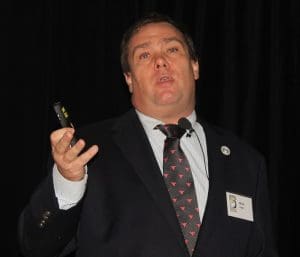
JBS Australia’s Mark Inglis
LAMB producers selling through saleyards were unlikely to get Livestock Data Link carcase feedback from major exporter JBS Australia, the 2017 BestWool BestLamb Conference was told in Bendigo last week.
At the conference JBS farm assurance and supply chain manager Mark Inglis said lamb producers should be excited about the coming information flow in their industry.
“What we are going to see in the next 10-15 years in regards to information flow, we’ve never seen in the lamb industry in the last 15-20 years.”
Past carcase feedback had only included fat score and carcase weights, but future grids would have lean meat yield, MSA index, forequarter and hind quarter yields, an Eating Quality index, and possibly a compliance bonus.
He urged lamb producers to get on to Livestock Data Link, which provided detailed carcase feedback into a lean meat yield calculation, fat score, carcase weight and grid compliance data.
“Hopefully in the future there will be more processors, other than us, getting on it, it is absolutely bloody fantastic.
“It gives feedback to producers in a way they can understand it and in a way that is meaningful.”
Click here to get the latest Sheep Central story links sent to your email inbox.
Mr Inglis said National Sheep Health Monitoring Project data has recently been added to LDL at JBS Brooklyn plant, although the NSHMP monitoring is only random.
“This is an area as we go forward that from a production perspective, you guys will be able to make huge gains with in around growth rates, because animal health does have an impact back on farm.”
Mr Inglis said JBS has been collecting lamb carcase data at its Bordertown, Brooklyn, Cobram and Longford for five years.
“So if you have supplied a JBS plant in the last five years across those states, you will have data waiting for you on LDL – so you can jump up there and grab it.”
He said JBS supplied LDL feedback to all its direct lamb suppliers, but not to producers selling lambs through saleyards.
“We can’t trace it back (via saleyards).
“Maybe (if they’ve got RFID tags), we don’t know yet.”
DEXA will not be an industry ‘saviour’
Summarising the status of current lamb carcase assessment techniques, Mr Inglis said palpated fat scoring had an accuracy of only 20pc, compared to 30pc with a GR knife. ViaScan’s lean meat yield assessment accuracy was only about 45pc, but DEXA technology had lifted this to 92pc on lamb.
DEXA has been used in JBS’ Bordertown plant to drive cutting robots for the last 2-3 years and should be operating in the Brooklyn plant by October, Mr Inglis said. But he said DEXA would not be an industry “saviour”.
“I’m really excited that we are starting to get somewhere, but what I want you to remember is it is not going to be the saviour for the livestock industry, for us or the lamb industry.
“All it does is, it measures bone, muscle and fat, that’s it; it doesn’t do anything else.
“It allows us to get a predicted lean meat yield outcome, for those carcases going through.”
Eating quality measurements needed
Mr Inglis said the industry needed to be looking eating quality in line with lean meat yield. Research was continuing with hyperspectral cameras and probes with the ability to measure intramuscular fat or IMF.
“If we don’t, we will end up like New Zealand; absolutely fantastically spec lamb, eats like sh..
“If we do not get an intramuscular objective fat measurement in the next two to three years, you can kiss MSA lamb goodbye – it is needed.”
He said lambs needed 4-6pc intramuscular fat for eating quality, but he said Sheep CRC work has shown a “worrying trend” of IMF levels in the flock of less than 4pc.
Mr Inglis said he had occasionally at Bordertown got some feedback about dog bites on carcases, but not at the Brooklyn plant, until the NSHMP data was accessed for the first time.
“There were 617 cases of dog bite in there.”
The National Sheep Health Monitoring Project monitors sheep carcases in abattoirs for animal health conditions that reduce profit across the value chain through productivity losses and/or increases in meat processing wastage. NSHMP monitoring currently occurs in 14 domestic and export processing plants for a range of sheep production health and welfare conditions, with the intent to get more processors involved in the program.
LDL feedback for lamb and sheep is currently available only to producers supplying JBS Southern plants, with more plants expected to come on by the end of the year. MLA anticipates that by the end of the year a minimum of four additional sheep establishments will be releasing carcase compliance data to producers.
MLA said there is significant interest in LDL from sheep processors, driven by the industry discussion around objective carcase measurement and the need to have effective vehicles to feed this information back to producers. There is interest from several of the NSHMP establishments in extending LDL to incorporate the carcase compliance aspects.
In terms of animal health data, sheep producers can access their animal health data from all the establishments participating in the NSHMP. This involves more than 7000 PICs.



HAVE YOUR SAY